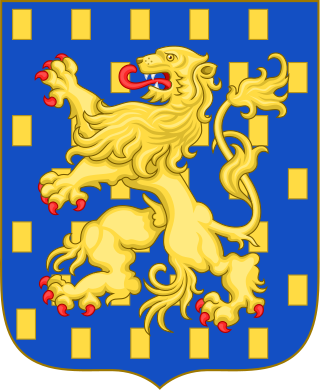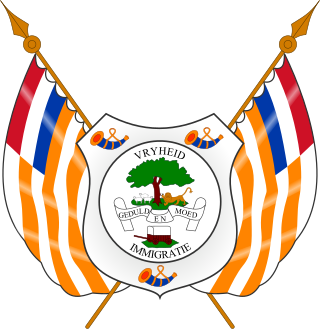
The House of Orange-Nassau is the current reigning house of the Netherlands. A branch of the European House of Nassau, the house has played a central role in the politics and government of the Netherlands and elsewhere in Europe, particularly since William the Silent organised the Dutch Revolt against Spanish rule, which after the Eighty Years' War (1568–1648) led to an independent Dutch state.

Prince of Orange is a title originally associated with the sovereign Principality of Orange, in what is now southern France and subsequently held by sovereigns in the Netherlands.

In heraldry, cadency is any systematic way to distinguish arms displayed by descendants of the holder of a coat of arms when those family members have not been granted arms in their own right. Cadency is necessary in heraldic systems in which a given design may be owned by only one person at any time, generally the head of the senior line of a particular family.

The coat of arms of the Kingdom of the Netherlands was originally adopted in 1815 and later modified in 1907. The arms are a composite of the arms of the former Dutch Republic and the arms of the House of Nassau, it features a checkered shield with a lion grasping a sword in one hand and a bundle of arrows in the other and is the heraldic symbol of the monarch and the country. The monarch uses a version of the arms with a mantle while the government of the Netherlands uses a smaller version without the mantle (cloak) or the pavilion, sometimes only the shield and crown are used. The components of the coats of arms were regulated by Queen Wilhelmina in a royal decree of 10 July 1907, affirmed by Queen Juliana in a royal decree of 23 April 1980.

The House of Nassau is a diversified aristocratic dynasty in Europe. It is named after the lordship associated with Nassau Castle, located in present-day Nassau, Rhineland-Palatinate, Germany. The lords of Nassau were originally titled "Count of Nassau", then elevated to the princely class as "Princely Counts". Early on they divided into two main branches: the elder (Walramian) branch, that gave rise to the German king Adolf, and the younger (Ottonian) branch, that gave rise to the Princes of Orange and the monarchs of the Netherlands.
The state of Prussia developed from the State of the Teutonic Order. The original flag of the Teutonic Knights had been a black cross on a white flag. Emperor Frederick II in 1229 granted them the right to use the black Eagle of the Holy Roman Empire. This "Prussian Eagle" remained the coats of arms of the successive Prussian states until 1947.

In heraldry and heraldic vexillology, a blazon is a formal description of a coat of arms, flag or similar emblem, from which the reader can reconstruct the appropriate image. The verb to blazon means to create such a description. The visual depiction of a coat of arms or flag has traditionally had considerable latitude in design, but a verbal blazon specifies the essentially distinctive elements. A coat of arms or flag is therefore primarily defined not by a picture but rather by the wording of its blazon. Blazon is also the specialized language in which a blazon is written, and, as a verb, the act of writing such a description. Blazonry is the art, craft or practice of creating a blazon. The language employed in blazonry has its own vocabulary, grammar and syntax, which becomes essential for comprehension when blazoning a complex coat of arms.

The coat of arms of Amsterdam is the official coat of arms symbol of the city of Amsterdam. It consists of a red shield and a black pale with three silver Saint Andrew's Crosses, the Imperial Crown of Austria, two golden lions, and the motto of Amsterdam. Several heraldic elements have their basis in the history of Amsterdam. The crosses and the crown can be found as decorations on different locations in the city.

De Graeff is an old Dutch patrician and noble family,

The coat of arms of the Orange Free State was the official heraldic symbol of the Orange Free State as a republic from 1857 to 1902, and later, from 1937 to 1994, as a province of South Africa. It is now obsolete.

The coat of arms of Sint Eustatius consists of a shield and the motto. It was established on 9 November 2004 by the Island council of Sint Eustatius, when it was still part of the Netherlands Antilles. It remained the coat of arms of Sint Eustatius after the dissolution of the Netherlands Antilles and the subsequent change of Sint Eustatius's constitutional status into a special municipality of the Netherlands in 2010.

The emblem of Curaçao is a yet to be adopted national symbol of Curaçao. The design will be based on a concept by Adresetti Monart featuring the Queen Emma Bridge, a cactus, a hummingbird and a traditional fishing boat, which was chosen through a design competition held in 2022. The emblem is set to replace the coat of arms of Curaçao, which has been in use since 24 July 1964.

The Dutch Republic Lion was the badge of the Union of Utrecht, the Republic of the Seven United Netherlands, and a precursor of the current coat of arms of the Kingdom the Netherlands.

The coat of arms of Hoorn is a coat of arms that has been in use since the middle ages. Although over time it underwent some changes, there has been no change to the coat of arms since it was acknowledged in use by the High Council of Nobility in 1816. At present, in the original form, it is the coat of arms of the municipality of Hoorn. The current municipality was formed in 1979 by merging the city of Hoorn with the villages Zwaag and Westerblokker; it was decided to use the old coat of arms as coat of arms of the new municipality.

The coat of arms of Zaanstad has been formally acknowledged since 27 February 1974. The coat of arms was previously that of the jurisdictional area of Westsane en Crommenie, which now form the municipality of Zaanstad. These two areas were on the same areas as the municipalities who fused in 1974 to become the municipality of Zaanstad. The municipality of Assendelft alone used a coat of arms who didn't look like those of the other municipalities. The other municipalities and places used a coat of arms with four lions in it.

The coat of arms of Enkhuizen has been the coat of arms ever since Enkhuizen received borough rights in 1355. The coat of arms was acknowledged in 1816 by the High Council of Nobility, the coat of arms has not been changed ever since.
This page shows the coats of arms, heraldic achievements, and heraldic flags of the House of Nassau.

Jhr. Jacob van den Eynde was a Dutch Governor of Woerden. He was the son of Grand Pensionary Jacob van den Eynde, and father of the Zeelandic poet Jacob van den Eynde, better known as Jacobus Eyndius.

Jan Pietersz Graeff was an Amsterdam regent and cloth wholesaler from the 16th century.

Andries Boelens, also: Boelenz, Boelensz., Andries Boel Dircksz. or Andries Boelen Dircksz, was an alderman and mayor of Amsterdam. In the period from 1496 to 1517 he was mayor fifteen times. The term of his office is the first to be characterized as a period with a rather closed government elite. Because of this he was one of the founders of the Amsterdam oligarchy. Boelens is considered the progenitor of the Amsterdam regents of the Dutch Golden Age such as the De Graeff and Bicker families who largely claimed descent and their political legality from him.



















